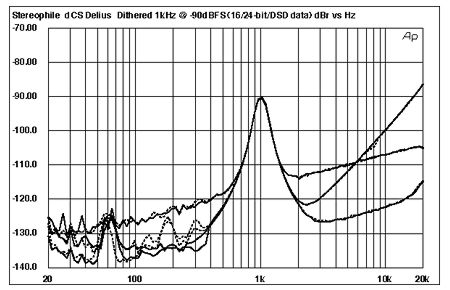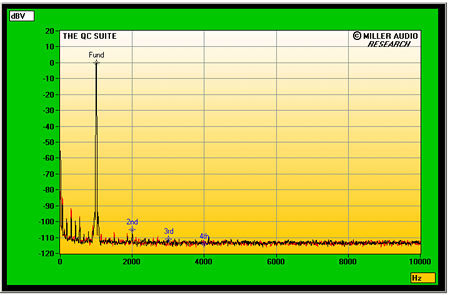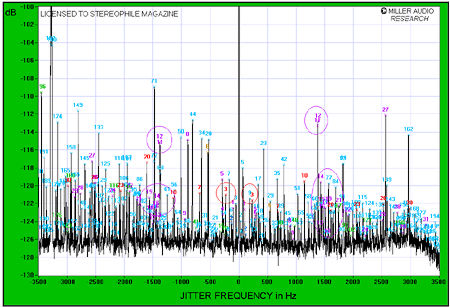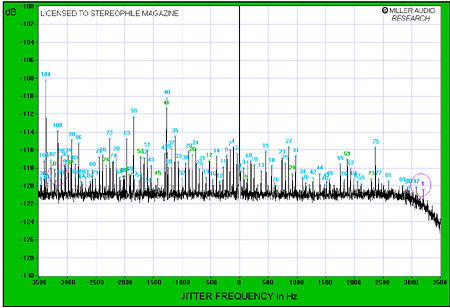| Columns Retired Columns & Blogs |
dCS Verdi La Scala CD/SACD transport & Delius D/A converter Measurements
Sidebar 3: Measurements
Because Stereophile has already reviewed both the dCS Verdi SACD/CD transport (in April 2003) and the Purcell upsampler (in January 2001 and April 2003), I didn't feel it necessary to measure the Verdi La Scala, which incorporates the functionality of both units in one chassis. I concentrated, therefore, on the Delius D/A processor, feeding it DSD-sampled data from a Verdi transport and 16- and 24-bit LPCM data from a computer, using an RME Digi96/8 Pro soundcard and a TosLink S/PDIF connection. The Delius had no problem locking on to data sampled at rates up to 96kHz with a single connection or at 192kHz with a dual AES/EBU connection.
As reviewed, the Delius' maximum output was 2.025V RMS with both DSD and LPCM data, 0.1dB higher than required by the CD standard, and the volume control operated in accurate steps of 0.5dB. The Delius preserved absolute polarity from both unbalanced and balanced outputs, the latter wired with pin 2 hot. The output impedance was very low, below 0.5 ohm, at almost all frequencies, rising slightly at 20kHz to just below 1 ohm.
Fed CD data, the Delius' frequency response was perfectly flat in the audioband (not shown). Using the factory default filter setting with DSD data (fig.1, top traces), the response extended out to –3dB at 72kHz. With 96kHz-sampled data, the output was down 3dB at 41kHz; with 192kHz data, the output extended to 90kHz. Channel separation (not shown) was excellent at 103dB R–L and 114dB L–R across the audioband.

Fig.1 dCS Delius, 96kHz-sampled data (bottom at 30kHz), SACD data (middle at 50kHz), and 192kHz-sampled data (top at 70kHz) at –3dBFS, frequency response into 100k ohms (right channel dashed, 0.5dB/vertical div.).
The Delius offers superb resolution, as shown in fig.2. This graph was produced by sweeping a 1/3-octave–wide bandpass filter down from 20kHz as the Delius was fed 16- and 24-bit LPCM data, then DSD data, all three representing a dithered 1kHz tone at –90dBFS. The top trace below 5kHz in fig.3 shows the spectrum produced with 16-bit data. The tone peaks exactly at –90dBFS, and the noise floor is basically that of the dither used to linearize the data. Increasing the word length to 24 bits (bottom trace) drops the noise floor by 14dB or so in the treble, implying almost 19-bit performance, which is excellent.

Fig.2 dCS Delius, 1/3-octave spectrum of dithered 1kHz tone at –90dBFS, with noise and spuriae, DSD SACD data (top above 5kHz), 16-bit CD data (top below 5kHz), and 24-bit PCM data (bottom). (Right channel dashed.)
DSD data produced the usual rising trace in the treble (top trace above 5kHz), due to the presence of the 1-bit encoding system's noiseshaping, but is as good as 24-bit PCM in the midrange and treble. Note the presence of some very-low-level power-supply hum with the hi-rez data: a 60Hz component present at –125dB in both channels and a 180Hz component in the right channel at the same level. These are presumably due to magnetic coupling from the power transformer, but are so low in level that they will be inconsequential.
As well as very low noise, the Delius features superb DAC linearity. The error in absolute level is plotted in fig.3, taken with both 16- and 24-bit PCM data. With 16-bit data (top pair of traces), the slight positive error seen below –100dBFS is due to the dither noise, not to the DAC itself. With 24-bit data (bottom traces), the error remains below ±0.25dB to the left-hand edge of the graph at –120dBFS. This is superb DAC performance, so it came as no surprise that the dCS's reproduction of an undithered 16-bit sinewave at –90.31dBFS (fig.4) was essentially perfect, with the three discrete voltage levels readily evident and the positive- and negative-going steps precisely balanced. Increasing the word length to 24 bits gave a good facsimile of a sinewave (fig.5).

Fig.3 dCS Delius, departure from linearity, 16-bit (top below –90dBFS) and 24-bit PCM data (right channel dashed, 2dB/vertical div.).

Fig.4 dCS Delius, waveform of undithered 1kHz sinewave at –90.31dBFS, 16-bit PCM data.

Fig.5 dCS Delius, waveform of undithered 1kHz sinewave at –90.31dBFS, 24-bit PCM data.
Distortion was at the limit of my measurement system, with a 1kHz tone at 0dBFS reproduced with just 0.0007% THD (true sum of the harmonics). As shown by fig.6, the second harmonic was the highest in level in the left channel, at just –104.5dB but below the noise floor in the right channel. (Ignore the low-level spuriae in this and fig.7, which are due to a ground loop that I couldn't eliminate between the Delius and the computer that houses the National Instruments PCI card that I used for these measurements.) Intermodulation distortion was also vanishingly low in level (fig.7).

Fig.6 dCS Delius, spectrum of 1kHz sinewave, DC–1kHz, at 0dBFS into 4k ohms, DSD data (linear frequency scale).

Fig.7 dCS Delius, HF intermodulation spectrum, DC–25kHz, 19+20kHz at 0dBFS into 4k ohms, 16-bit PCM data (linear frequency scale).
Only in its rejection of word-clock jitter on external data did the Delius stumble a little. Fig.8 shows a narrowband spectrum of the Delius' analog output while it decoded 16-bit data representing the diagnostic signal developed by the late Julian Dunn. Data-related components (indicated with red numeric markers) are fairly low in level, but the noise floor is a little higher than the best CD-playback components I have measured, and is marred by many discrete noise spikes. The measured jitter level was 424 picoseconds peak–peak, which is about three times higher than the best components I have measured on this test. It seems to stem mainly from sidebands with frequencies 1.4kHz on either side of the central tone (purple "11" and "12").

Fig.8 dCS Delius, 16-bit CD data, high-resolution jitter spectrum of analog output signal; source, PC WAV file via RME soundcard and TosLink connection (11.025kHz at –6dBFS sampled at 44.1kHz with LSB toggled at 229Hz). Center frequency of trace, 11.025kHz; frequency range, ±3.5kHz.
Increasing the word length to 24 bits reduced the jitter to 399ps, due to the data-related components dropping below the noise floor, but the noise spikes remained in evidence (not shown). Playing the 16-bit jitter signal CD on the Verdi transport without upsampling, with the Verdi acting as the word-clock master reduced the jitter level to 291ps, while slaving the transport to the DAC's word-clock output gave a further reduction to 276.5ps. Interestingly, deriving the master clock from the DAC pushed the jitter sidebands up higher in frequency (fig.9).

Fig.9 dCS Delius, 16-bit CD data, high-resolution jitter spectrum of analog output signal; source, dCS Verdi word-clock-slaved to Delius, IEEE1394 data connection (11.025kHz at –6dBFS sampled at 44.1kHz with LSB toggled at 229Hz). Center frequency of trace, 11.025kHz; frequency range, ±3.5kHz.
I don't have an SACD with the diagnostic tone, but Sony's "provisional" Test SACD has a high-level tone at 11.025kHz. Playing that track on the Verdi into the Delius gave the spectrum shown in fig.10. The noise floor is higher than with PCM data because I had to reduce the playback level to avoid clipping the measurement card's ADC. (I used an external analog volume control rather than the Delius' digital control to keep the playing field level.) The jitter level is an extraordinarily low 63ps, but this will be mainly due to the tone not having the low-level content to induce data-related jitter.

Fig.10 dCS Delius, DSD data, high-resolution jitter spectrum of analog output signal; source, SACD played on dCS Verdi transport, Delius word-clock-slaved to Verdi, IEEE1394 data connection (11.025kHz at –6dBFS). Center frequency of trace, 11.025kHz; frequency range, ±3.5kHz.
The Delius didn't reject word-clock jitter from external S/PDIF data sources as much as I would like to have seen, though it is fair to point out that this will be a nonissue when the Delius is used with the La Scala transport. In all other respects, its measured performance is beyond reproach.— John Atkinson
- Log in or register to post comments




































